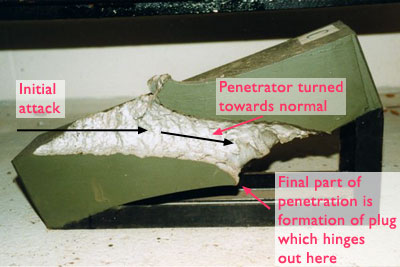
Logo from Scott Cunningham.

Logo from Scott Cunningham.
![]() he major differences between the mechanism of plate penetration by sub-calibre penetrators and by conventional steel projectiles arise from the very great difference in the ratio of thickness to diameter ratio. Thus, while conventional steel projectiles are seldom capable of penetrating more than 2 calibres of plate, sub-calibre penetrators may penetrate eight (World War II) or more calibres thick. The high velocities at which sub-calibre projectiles are fired, and their high densities, result in striking energies at least four or five times greater than that associated with a steel projectile of the same calibre as a penetrator. This high energy, together with freedom from shatter, account for the great calibre thickness of plate penetrated.1
he major differences between the mechanism of plate penetration by sub-calibre penetrators and by conventional steel projectiles arise from the very great difference in the ratio of thickness to diameter ratio. Thus, while conventional steel projectiles are seldom capable of penetrating more than 2 calibres of plate, sub-calibre penetrators may penetrate eight (World War II) or more calibres thick. The high velocities at which sub-calibre projectiles are fired, and their high densities, result in striking energies at least four or five times greater than that associated with a steel projectile of the same calibre as a penetrator. This high energy, together with freedom from shatter, account for the great calibre thickness of plate penetrated.1
For a sub-calibre penetrator there is little tendency to form a plug until perforation is nearly complete, and during most stages of penetration the plate may be regarded as approximating an infinite mass. After the head has entered the material and front petalling has ceased, if further penetration is to occur the volume of material displaced by the ogive must be accommodated by elastic deformation. The material immediately around the projectile will be deformed plastically, and will be reduced in volume by an amount corresponding to the elastic part of the strain. Therefore, a large zone of plate material surrounding the plastically deformed zone must also be subjected to elastic compression to account for the full volume of material displaced.1

An attack by a modern APDS or APFSDS projectile. During most of the travel through the plate penetration is achieved by plastic deformation. Only at the end is a plug formed. From the private collection of Chris Shillito.
This is an important part of the process of penetration in the case of sub-calibre projectiles where the thickness of the plate is large in relation to the calibre. These conditions are not normally encountered in the attack of plate by full calibre kinetic energy projectiles due to the influence of the back face overlapping that of the front face at thicknesses of two calibres or less.1
The tungsten carbide used for penetrators is relatively brittle and as a result early penetrators break up when they strike armour obliquely, so that their armour piercing performance falls off appreciably as the slope of the target armour increases. This effect can be reduced but not eliminated by sheathing the core with steel, but this was only done by Britain in World War II. For British projectiles the modified de Marre formula given by equation (4) provided a good fit to observed results, but it was recommended that the constant n should be reduced from 1.43 to more nearly unity.1 The detrimental effect of obliquity affected post World War II APDS up to and including the 105mm L22 projectile.3
Post World War II APDS projectiles, from the 105mm L28 projectile (and its USA counterpart the M392) onwards, incorporated a tugsten alloy cap to the penetrator to reduce shattering. This was a major improvement in design that resulted in these projectiles suffering to a much lesser extent from obliquity.3
For APFSDS projectiles, there is no effect to their line of sight penetration due to obliquity up to about 70°. This makes them as effective against sloping armour as against vertical armour of the same weight, in contrast to all other kinetic energy projectiles, and increases their superiority over the latter.3
 Equations Describing the Effect of Obliquity on All Anti-Armour Projectiles
Equations Describing the Effect of Obliquity on All Anti-Armour Projectiles
Do you like this web site? Please rate it between one and ten, with ten being the best:
Ratings are submitted to: The Wargames and Military History Search Engine.
Copyright © 2000 David Michael Honner. E-mail: GvA@wargamer.org.